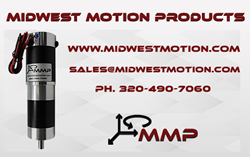The total process of building a robot is first to identify a need, then defining the problem that must be overcome to accomplish the need.
Len Calderone for | RoboticsTomorrow
So you want a robot? Why? Before you design a robot, you will need to decide the goal or problem that you are addressing. There are many designs for robots from assembly line robots to first responder robots. Each type of robot will handle a situation differently. Therefore, you will need to understand exactly what you need to accomplish before designing the robot. You might even find a ready-made model that will fit the bill.
When the word "robot" is used, many people think of the humanoid-type robots seen in the movies. Actually, today's robots are quite simple devices. Motions that we take for granted, such as picking up a coin from the table, is very complicated for a robot; but if designed properly, a robot can perform the operation with exactly the same motions without tiring and with unerring accuracy while operating 24/7. Because of this repeatability, robots are mostly designed for industrial work, such as repetitive painting and welding, while others are used to lift and place products into machines and packages.
Start by writing a brief description in a note book. This can be modified as you progress with the design. Just write a short statement, explaining what you want the robot to do. Be prepared to consider alternative designs should the first concept not be practical. It wouldn't hurt to add drawings. They don't have to be perfect, but the drawings will help your thought process.
Some of the things that you will need to consider in your design are the robot's movement; how it will be powered; and the brain behind the machine. Its movement will be decided by the environment in which the robot will be used and the space allotted. You will need to decide what functions the robot will perform within this space; and you will need to determine whether the robot will run on building current or a battery. One of the more difficult designs will be its brain. How much will the robot need to sense for the job at hand?
The general shape will be essential to the robot's strength, durability, stability and safety. Then the materials used to build the robot must be considered for suitability, as robots are made of out everything from plastic to stainless steel.
The physical properties of materials used in robotic design have many elements that need to be considered. Should the materials be soft or hard? Elastic modulus is the material's stiffness, or how hard it is to stretch, bend, or compress when placed under stress. A material with a low elastic modulus will be stretchable and pliable. A material with a high elastic modulus will be hard, like metal. Materials deform differently when loads and stresses are applied. The ability of matter to resist or transmit stress is important when determining if a particular material is suitable for a specific robotic purpose. The modulus of elasticity is already known for a wide variety of materials, including metals, wood, glass, rubber, ceramics, concrete, and plastics.
Stress is a force applied over an area, stated in units of pounds per square inch (psi). Strain is a measure of the amount that a material deforms when stress is applied and is calculated by measuring the amount of deformation when under stress. Modulus of elasticity can be calculated by dividing the stress by the strain.
Elasticity is the ability of a material to return to its original state after a load, or stress, is removed. Elastic strain is reversible, and the material will return to its previous condition. If exposed to intense levels of stress, materials may deform and will not return to its original dimensions. This is referred to as plastic deformation or plastic strain.
Common material is used to build most robots but some specialized models use special materials such as Titanium or composite carbon fibers. The operating environment and strength required are major factors in material selection. Steel, cast iron, and aluminum are most often used for the arms and bases, and if the robot is mobile, it will have rubber tires. Other design considerations are the electronics and wiring, as well as hydraulic oil or pressurized air control.
Recently, highly automated design synthesis techniques have emerged. The availability of modern computing tools can simplify the performance capabilities that need to be evaluated before a suitable configuration is selected. When the designer is confronted with many choices for the type and layout of the parts in the initial design phase, selection is based on the knowledge of the task, the workspace and the designer's own experience.
An option to this method is to use software tools that assist the designer in the design process. Current synthesis and analysis software tools can give the designer the flexibility in exploring choices by building computer generated models, which increase confidence in the design selection.
Synthesis software makes alternative configurations easier. Several programs that model and simulate robots are Robotics Toolbox for serial link design; Robotect for modeling and analysis; RobotAssist for robot modeling and control; and CimStation Robotics, which is 3-D simulation software for manufacturing automation.
Synthesis and processing science is an important component in the design of a wide variety of relevant materials. In the field of robotics, the desire is to emulate human-like movement characteristics, which are important to the operation of a robot. One of the foremost problems with the synthesis of human movement is repetition. The goal is to understand human motion. Therefore, mathematical models have proven to be valuable tools for motor control prediction, which characterize some element of musculoskeletal movement.
Once the completed robot is functional, a computer program instructs the controller to move the robot through a series of motions. Accurate recordings of these motions are made, and any problems are corrected.
The total process of building a robot is first to identify a need, then defining the problem that must be overcome to accomplish the need. Make a list of the objectives and list them in order of importance, remembering that a single robot might not be able to handle every segment of the need. You should explore other solutions to the same or similar problem. The answer to your problem might already exist. Then, analyze the environment in which the robot will work, paying particular attention to specifically required dimensions and measurements.
The design phase of a robot is the most challenging of the entire process. A proficient designer must be adaptable when making hard decisions, and willing to make trade-offs and exceptions so that the design is workable and practical. Then, the complete design is translated to a CAD drawing with virtual prototyping of the robot in the computer to discover any flaws that might exist.
The next stage is to build a prototype, which is an accurate working model of the final design. The prototype is evaluated for cost, aesthetics, durability, ease of construction, and meeting the design criteria. This is the stage where changes or redesigns are made if the solution does not fully meet the need. At this point, it is time to actually build the robot.
|
Len Calderone - Contributing EditorLen contributes to this publication on a regular basis. Past articles can be found with an Article Search and his profile on our Associates Page He also writes short stores that always have a surprise ending. These can be found at http://www.smashwords.com/profile/view/Megalen.
|
 |
The content & opinions in this article are the author’s and do not necessarily represent the views of RoboticsTomorrow
Featured Product


